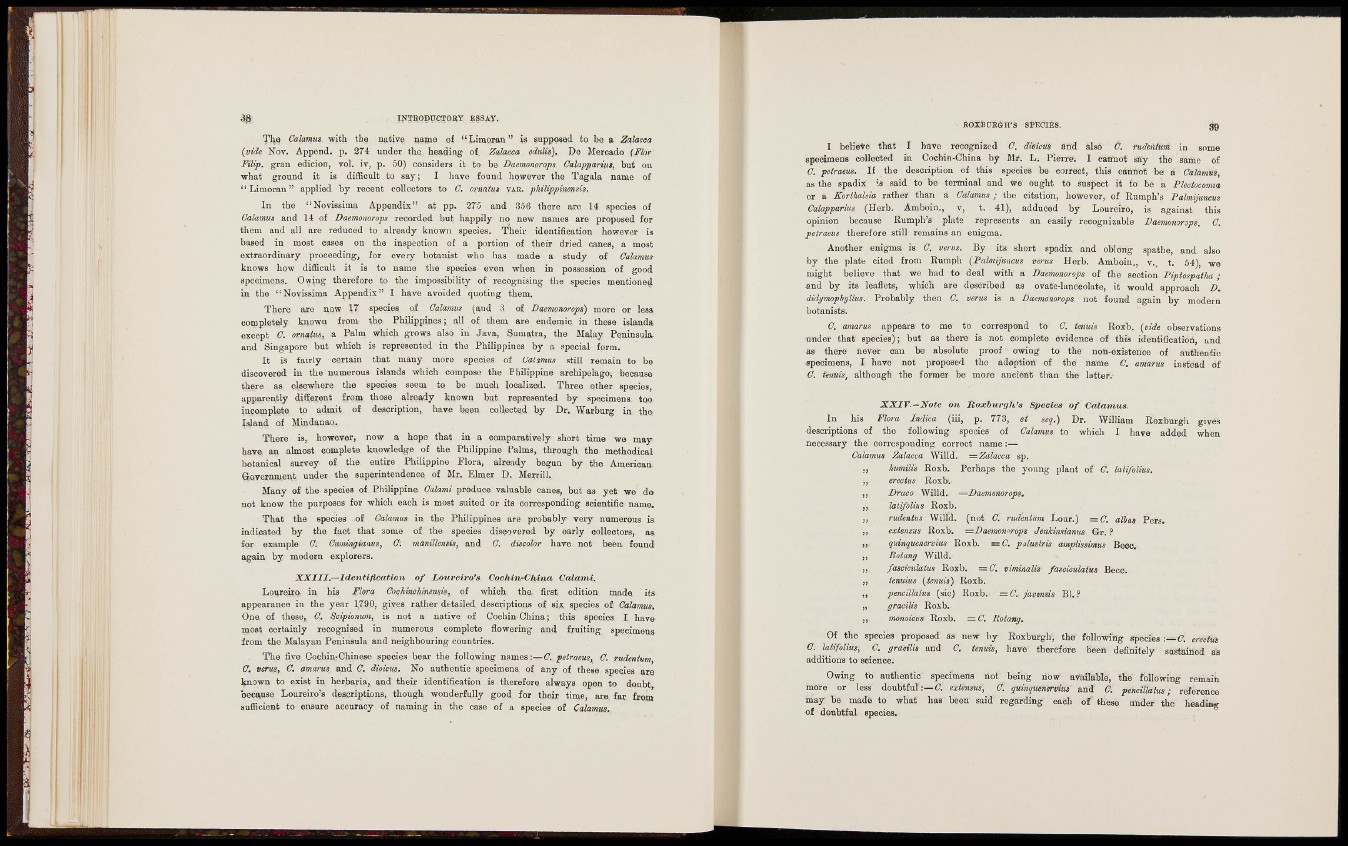
INTHODüCTOar ESSAY.
The Calamui with the native name of "Liraoran" is siippcwed to bo a Zqlauca
(vide Nov. Append, p. 27-t under the heading of Zalacoa odulis). De Mercado (Flor
Filip. gran edición, vol. iv, p. 50) considera it to be Dacmonorops Calappariu», but ou
what ground it is difficult to say; I have found however the Tagala name of
" L i m o r a u " applied by recent coUcctora to C. ornatus VAE. philippinensis.
In the "Novissima Appendix" at pp. 275 and 356 there are 14 species of
Galamvs and 14 of Daemonorops recorded but happily no new names are proposed for
them and all are reduced to already known species. Their identification however is
based in most cases on the inspection of a portion of their dried canes, a most
extraordinary proceeding, for every botanist who has made a study of Galafnus
knows how difficult it is to name the species even when in possession of good
specimens. Owing therefore to the impossibility of recognisiug the species mentioned
in the "Noyissima Appendix" I have avoided quoting them.
There are now 17 species of Calamus (and 3 of Daemonorops) more or leas
completely known from the Philippines; all of them are endemic in these islands
except C. ornatus, a Palm which grows also in Java, Saoiatva, the Malay Peninsgla.
and Singapore but which is represented in the Philippines by a special form.
It is fairly certain that many more species of Oahmus still remain to be
discovered in the numerous islands which compose the Philippine archipelago, because
there as elsewhere the species seem to be muoh localized. Three other species,
apparently different from those already known but represented by specimens too
incomplete to admit of description, have beea collected by Dr. Warburg in th&
Island of Mindanao.
There is, however, now a hope that in a comparatively short time we may
have an almost complete knowledge of the Philippine Palms, through the methodical
botanical survey of the entire Philippine Flora, already begun by the American
GoTernment under the superintendence of Mr. Elmer D. Merrill.
Many of the speciea of Philippine Calami produce valuable canes, but as yet we do
not know the purposes for which each is most suited or its corresponding acientific name.
That the species of Calamus in the Philippinea are probably very numerous is
indicated by the fact that some of the species discovered by early collectors, as
for example C. Cumingianus, C. manillemis, and C. discolor have not been found
again by modern explorers.
XXIII.—Identification of Loureiro's Cochin-China Calami.
Loureiro in his Flora Cochinchinensis, of which the first edition made its
appearance in the year 1790, gives ra,iher detailed descriptions of six species of Calamus.
One of these, C. Scipionum, is not a native of Cochin-China; this species I have
most certainly recognised in numerous complete flowering and fruiting specimens
from the Malayan Peninsula and neighbouring countries.
The five Cochin-Chinese species bear the following names:—C. petraeus, 0. rudenium
C. vcrus, C. amarus and C. dioicm. No authentic specimens of any of these species are
known to exist in herbaria, and their identification is therefore always open to doubt
because Loureiro's descriptions, though wonderfully good for their time, are far from
sufficient to ensure accuracy of naming in tlie case of a species of Calamus.
ROXBaRQj-rs SPECIES. 39
I beliete that I have recognized C. dioicus and also C. rudefittm in some
specimens coilected in Coehin-China by Mr. L. PieiTe. I cannot say the same of
C. petraeus. I£ the description of this species be correct, this cannot be a Calamus,
as the apadix is said to bo terminal and we ought to suapect it to be a Plecioeomia
or a Eorthaliia rather than a Calamus ; the citation, however, of Rumph's Palmijuncus
Calapparius (Herb. Amboin,, v, t. 41), adduced by Loureiro, is against this
opinion because Uumph's plate represents an easily recognizable Daejiionorops. C.
petraeus therefore still remains an enigma.
Another enigma is C. verus. By its short spadix and oblong spatbe, and also
by the plate cited from Rumph {Falmijuneus verus Herb. Amboin., v., t. 64), we
might believe that we had to deal with a Daemonorops of the section Piptospaiha ;
and by its leaflets, which are described as ovate-lanceolate, it would approach D.
didnmophjllus. Probably then C. verus is a Daemonorops not found again by modern
botanists.
C. amarus appears to me to corresjiond to 0. tenuis Roxb. [vide obseivationa
under 1;hat species); but as there is not complete evidence of this identification, and
as there never can be absolute proof owing to the non-existence of authentic
specimens, I have not proposed the adoption of the name C. amarus instead of
C. tenuis, although the former be more ancient than the latter.
XXIV.-Note on Boxhurah's Specie>i of Calamus.
I n his Flora Indica (iii, p. 773, et soq.) Dr. William Roxburgli gives
descriptions of the following species of Calamus to which 1 have added when
necessary the corresponding correct name:—
Calamus Zalacca Willd. =Zalacca sp.
humilii Roxb. Perhaps the young plant of C. latifoUus.
erecius Roxb.
Draco Willd. —Daemonorops.
lalifolihs Roxb.
rudentus Willd. (not C. rudentum Lour.) =C. albas Pers.
exienstis Roxb. =.Daemon"rops Jenkiivtianus Gr. ?
quinquenervius Roxb. =C. palusiris amplissimus Becc.
Botang Willd.
faacieulatu.'i Roxb. vimnalis fasoieulaius Becc.
ienuius (tenuis) Roxb.
pencillalus (sic) Roxb. =.C. javtnsis Bl.?
gracilis Roxb.
monoicus Roxb. = C.
Of the species proposed as new by Roxburgh, the following species :—C. emtus
C. laWolius, 0. ¡jracilis and C. tenuis, have therefore been definitely sustained as
additions to acience.
Owing tb authentic specimens not being now available, the following remain
more or less doubtful :—(7. eztensus, C. quinquenervius and C. pencillaius ; reference
may be made to what has been said regarding each of these under the heading
of doubtful species.